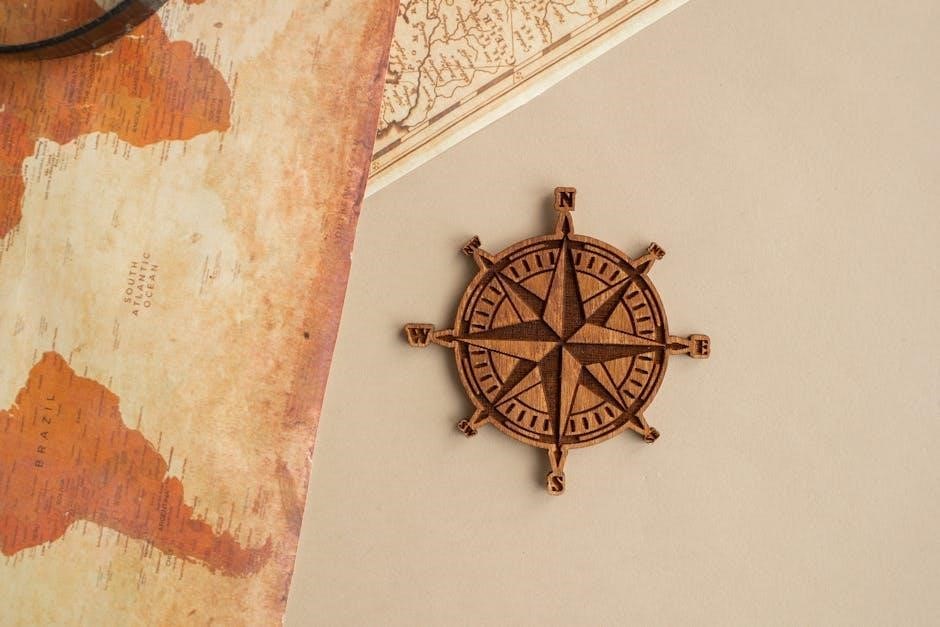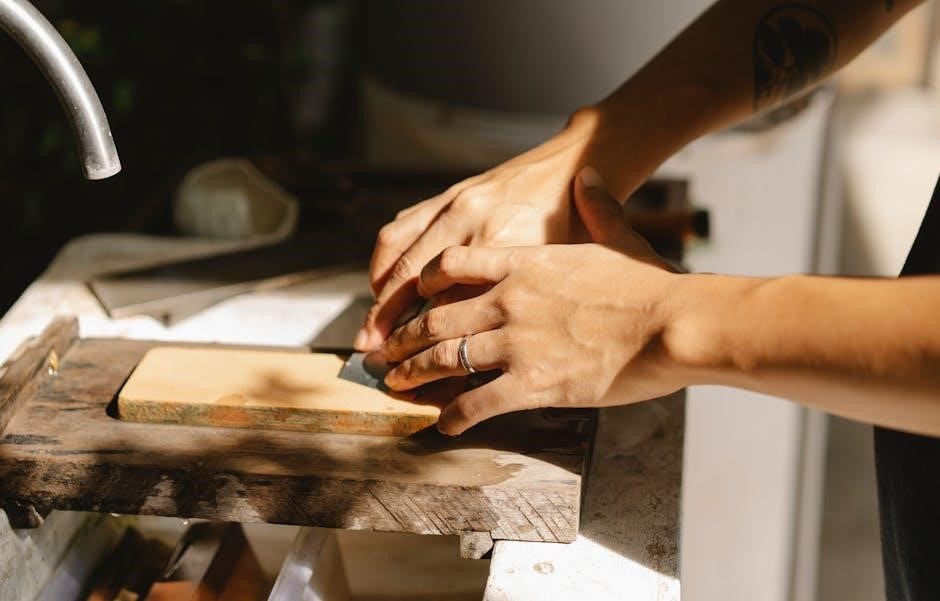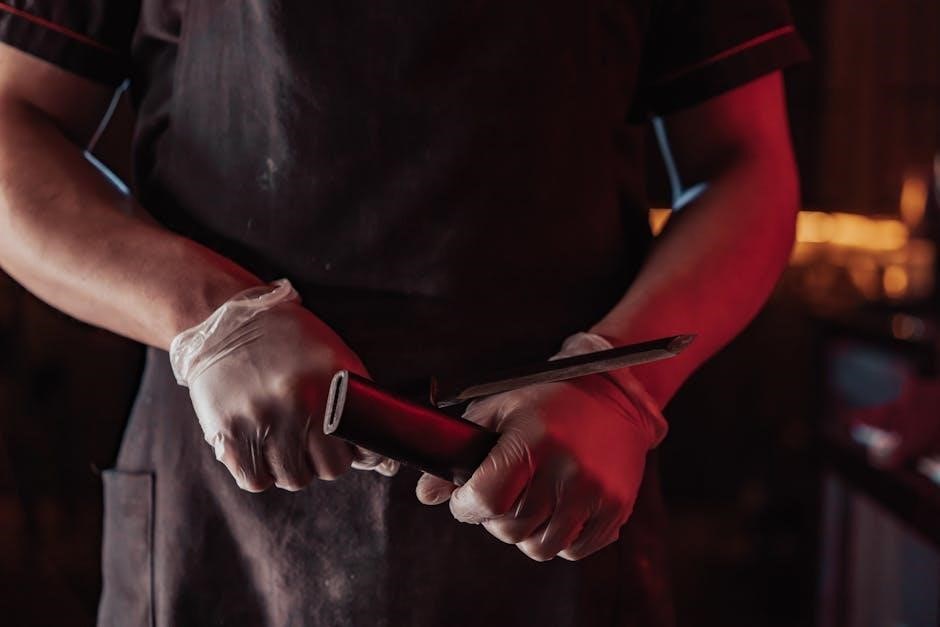Sharpening angle guides are essential tools for maintaining precise edge angles during sharpening, ensuring consistency and effectiveness; They simplify the process, offering manual, adjustable, and digital options for various tools and knives.

Understanding Sharpening Angles
Sharpening angles determine the edge’s sharpness and durability, with lower angles creating sharper but more delicate edges. They vary by tool type, balancing performance and longevity for optimal results.
What Are Sharpening Angles?
Sharpening angles refer to the specific degree at which a tool’s edge is sharpened, measured in degrees. These angles determine the sharpness, durability, and overall performance of the tool. For example, a knife sharpened at a smaller angle, such as 15 degrees, will be sharper but more delicate, while a larger angle, like 30 degrees, results in a more durable edge. The choice of angle depends on the tool’s intended use, with kitchen knives often requiring angles between 20-30 degrees and axes or chisels needing steeper angles for heavy-duty tasks. Sharpening angles are critical because they directly impact the tool’s effectiveness and longevity. Properly set angles ensure optimal cutting performance while minimizing wear and tear. Using angle guides helps maintain consistency, making the sharpening process more precise and efficient. Understanding and mastering sharpening angles is essential for achieving professional-level results in tool maintenance.
Importance of Sharpening Angles
Sharpening angles play a critical role in determining the performance, durability, and effectiveness of a tool. A properly set angle ensures the edge is sharp enough for its intended use while maintaining resilience against wear. For instance, a knife sharpened at too shallow an angle may be prone to chipping, while a steep angle might make it too dull. The right angle balances sharpness and longevity, ensuring the tool functions optimally. Consistency in sharpening angles is equally important, as it prevents uneven edges and extends the tool’s lifespan. Additionally, precise angles enhance safety by reducing the risk of accidental cuts from overly sharp or unpredictably angled edges. Understanding and mastering sharpening angles is essential for achieving professional-grade results in tool maintenance and ensuring reliability in various applications.
Factors Affecting the Choice of Sharpening Angles
The choice of sharpening angles depends on several key factors, including the tool’s intended use, the type of knife or tool, and the desired sharpness. For instance, Japanese knives often use shallower angles (15°) for precision, while Western knives may use slightly steeper angles (20°) for durability. The material of the tool also plays a role, as harder steels may require more precise angles to maintain sharpness. Additionally, the user’s skill level and experience can influence angle selection, with professionals often opting for more specialized angles. Regional preferences and cultural practices further shape angle choices, as different traditions emphasize specific sharpening techniques. Ultimately, the goal is to balance sharpness, edge retention, and ease of maintenance, ensuring the tool performs optimally for its intended purpose.

Types of Sharpening Angle Guides
Sharpening angle guides come in manual, adjustable, and digital forms, offering simplicity, versatility, and precision for maintaining consistent edge angles during tool sharpening.

Manual Angle Guides
Manual Angle Guides
Manual angle guides are simple, cost-effective tools designed to help users maintain consistent sharpening angles. These guides typically feature fixed or pre-set angles, such as 15°, 20°, or 30°, making them ideal for specific tasks. They are often compact and portable, allowing for easy use in various sharpening setups. Many manual guides are designed for particular types of knives or tools, such as Japanese knives, which commonly use a 15° angle, or Western-style knives, which prefer a 20° angle. Users appreciate their simplicity, as they eliminate the need for complex adjustments. For instance, the Knifewear Angle Guide, mentioned in some reviews, offers both 15° and 20° options, catering to different knife styles. These guides are especially popular among beginners, as they provide a straightforward way to achieve precise angles without extensive experience. Despite their lack of adjustability, manual angle guides are reliable and effective for maintaining consistency in sharpening results.
Adjustable Angle Guides
Adjustable angle guides offer unparalleled versatility for sharpening, allowing users to customize the angle to suit specific tools or tasks. These guides typically feature a range of adjustable angles, often from 10° to 35°, enabling precise control for various knife styles, chisels, or other cutting tools. One notable feature is their ability to be calibrated to specific angles, ensuring consistency across multiple sharpening sessions. Many adjustable guides include incremental markings or detents, making it easier to set and maintain the desired angle. Durable materials, such as stainless steel or high-grade plastics, ensure long-term reliability. Professionals and serious enthusiasts often prefer adjustable guides due to their adaptability, as they can accommodate different tools and sharpening techniques. This flexibility makes them a valuable investment for those who work with a variety of edges and require exacting precision. Adjustable angle guides strike a balance between ease of use and advanced functionality, catering to both novice and experienced sharpeners alike.

Digital Angle Guides
Digital angle guides represent the pinnacle of precision and innovation in sharpening technology; These advanced tools utilize sensors and digital displays to provide real-time angle measurements, ensuring accuracy to within a fraction of a degree. Unlike manual or adjustable guides, digital models eliminate guesswork by offering instant feedback, which is particularly beneficial for novice sharpeners. Many digital guides come with pre-programmed angle settings for common tools, such as kitchen knives, chisels, and axes, allowing for quick and reliable setup. Some models also feature memory functions to store frequently used angles, enhancing efficiency. The integration of backlight displays and adjustable sensitivity further improves usability in various lighting conditions. Despite their higher cost, digital angle guides are favored by professionals who require unwavering precision and consistency; They are an indispensable asset for anyone seeking to elevate their sharpening skills to the next level, ensuring optimal results every time.

Selecting the Right Sharpening Angle
Choosing the correct sharpening angle depends on the tool’s intended use and edge type. A typical range is 20-30 degrees, with finer angles suited for precision and durability. Understanding the tool’s purpose ensures optimal results.
How to Choose the Right Angle for Your Tool
Selecting the right sharpening angle begins with understanding tool usage. For knives, common angles range from 15° to 30°, with Japanese knives often using shallower angles for sharpness. Tools requiring durability, like axes, benefit from wider angles around 30°. Consider the tool’s material and edge type; harder materials may need more precise angles. Personal preference also plays a role, as some users prioritize edge retention over sharpness. Testing different angles and observing performance helps determine the optimal angle. Guides and gauges can assist in maintaining consistency. Researching the tool’s typical angle range provides a starting point, but practical experience fine-tunes the choice. Balancing these factors ensures the tool performs optimally for its intended tasks.
Sharpening Angles for Different Types of Knives
Different knives require specific sharpening angles to maximize their performance. Japanese knives, such as sushi knives, often use shallower angles (12°-15°) for precision and sharpness. Western chef knives typically range between 18°-22° for a balance of durability and edge retention. Pocket knives and utility knives may use slightly steeper angles (20°-25°) for versatility in everyday tasks. Hunting knives often employ angles around 25°-30° for robustness and edge strength. Fillet knives, designed for precision, may use angles as low as 10°-15°. The choice of angle depends on the knife’s intended use and the user’s preference for sharpness versus durability. Understanding these variations ensures optimal sharpening results for each knife type, enhancing both functionality and longevity.

Optimal Angles for Various Tools
Optimal sharpening angles vary significantly across different tools, each designed for specific tasks. For instance, axes and chisels typically require broader angles, ranging from 25° to 35°, to ensure durability and robustness for heavy-duty applications. Plane irons, on the other hand, benefit from narrower angles, usually between 25° and 30°, to maintain a keen edge for precise woodworking. Straight razors and scalpels demand extremely precise angles, often between 15° and 20°, to achieve the sharpness needed for their delicate work. Understanding the optimal angle for each tool is crucial, as it directly impacts performance and longevity. Using the correct angle ensures tools remain effective and reliable, whether for woodworking, carving, or surgical procedures. This emphasizes the importance of adjusting sharpening techniques based on the tool’s intended use.

A Step-by-Step Guide to Using an Angle Guide
Using an angle guide involves preparing the tool, setting the desired angle, and sharpening with precision. This ensures consistent results and a razor-sharp edge every time.
Preparing Your Tool for Sharpening
Before using an angle guide, ensure your tool is ready for sharpening. Inspect the edge for nicks or damage and clean the tool to remove any debris. Position the tool on a stable surface, aligning it with the sharpening medium. Secure the tool if necessary, using a vise or holding it firmly. Set the initial angle using a marker or sharpie technique to mark the bevel. This step ensures consistency and helps achieve the desired edge. Proper preparation is crucial for effective sharpening and optimal results.

Setting Up the Angle Guide
To set up the angle guide, begin by selecting the desired angle based on the tool or knife type. For instance, choose 15° for Japanese knives and 20° for Western knives. Attach the guide to the sharpening medium, ensuring it aligns with the tool’s bevel. Adjust the guide to match the selected angle, using calibration markings or digital displays for accuracy. Secure the guide firmly to maintain consistency during the sharpening process. Proper setup ensures precise control over the sharpening angle, leading to a sharper and more durable edge. Regularly check the alignment to avoid deviations and achieve optimal results.
Sharpening Your Tool Effectively
Sharpening your tool effectively requires consistent angle maintenance and controlled strokes. Start by holding the tool firmly against the sharpening medium, aligning it with the guide. Apply light pressure for fine edges or moderate pressure for heavier tools. Use smooth, consistent strokes, moving from heel to tip to maintain even wear. Check progress periodically with a sharpie or magnifying glass to avoid over-sharpening. For knives, ensure the bevel aligns with the guide’s angle, such as 15° for Japanese knives or 20° for Western styles. Keep the edge clean by wiping debris with a cloth. Regularly inspect the guide’s calibration to ensure accuracy. By following these steps, you’ll achieve a sharp, durable edge tailored to your tool’s specific needs. Patience and practice will refine your technique, making sharpening a precise and efficient process.

Maintaining Consistency in Sharpening
Maintaining consistency requires regular calibration of your angle guide and using it for every sharpening session. Check the angle frequently with tools like the sharpie technique to ensure accuracy and repeatability.
Ensuring Repeatable Results
To achieve consistent sharpening results, it’s crucial to use your angle guide meticulously. Start by ensuring the tool is properly secured and the guide is aligned with the edge; Use a marker to visually track progress and maintain the same angle throughout. Regular calibration of your angle guide ensures accuracy over time. Additionally, sharpen in small, controlled strokes, checking your work frequently with the sharpie technique to verify the angle. Consistency also depends on maintaining the tool’s condition; a dull or damaged blade may require adjustments. By following these steps and staying attentive, you can reliably achieve the desired edge every time, making your sharpening process efficient and precise.
Calibrating Your Angle Guide
Calibrating your sharpening angle guide ensures precision and consistency in your sharpening process. Begin by placing the tool on a flat surface and attaching the guide according to the manufacturer’s instructions. Adjust the guide to the desired angle, using a protractor or digital calibrator for accuracy. Once set, secure the angle in place to prevent movement during sharpening. For digital guides, follow the calibration steps provided in the user manual, often involving a reset or alignment process. Regular calibration is essential, especially after extended use or transportation, to maintain reliability. Proper calibration ensures that every stroke is consistent, leading to a sharper and more durable edge. By taking the time to calibrate your guide, you enhance the effectiveness of your sharpening routine and extend the life of your tools.
Sharpening angle guides are indispensable tools for achieving precision and consistency in tool sharpening. By providing a structured approach to maintaining optimal angles, they simplify the sharpening process, making it more efficient and effective. Whether you’re sharpening knives, chisels, or other cutting tools, these guides ensure that the edge is honed to its fullest potential. With options ranging from manual to digital, there’s a guide to suit every skill level and need. Regular calibration and proper use of these guides not only enhance the sharpness of your tools but also extend their lifespan. By mastering the use of sharpening angle guides, you can elevate your sharpening skills, ensuring your tools remain in peak condition for years to come.
